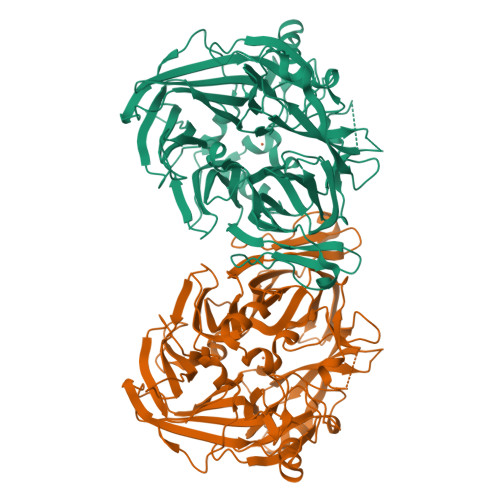Importance of membrane structural integrity for RPE65 retinoid isomerization activity.
Golczak, M., Kiser, P.D., Lodowski, D.T., Maeda, A., Palczewski, K.(2010) J Biological Chem 285: 9667-9682
- PubMed: 20100834
- DOI: https://doi.org/10.1074/jbc.M109.063941
- Primary Citation of Related Structures:
3KVC - PubMed Abstract:
Regeneration of visual chromophore in the vertebrate visual cycle involves the retinal pigment epithelium-specific protein RPE65, the key enzyme catalyzing the cleavage and isomerization of all-trans-retinyl fatty acid esters to 11-cis-retinol. Although RPE65 has no predicted membrane spanning domains, this protein predominantly associates with microsomal fractions isolated from bovine retinal pigment epithelium (RPE). We have re-examined the nature of RPE65 interactions with native microsomal membranes by using extraction and phase separation experiments. We observe that hydrophobic interactions are the dominant forces that promote RPE65 association with these membranes. These results are consistent with the crystallographic model of RPE65, which features a large lipophilic surface that surrounds the entrance to the catalytic site of this enzyme and likely interacts with the hydrophobic core of the endoplasmic reticulum membrane. Moreover, we report a critical role for phospholipid membranes in preserving the retinoid isomerization activity and physical properties of RPE65. Isomerase activity measured in bovine RPE was highly sensitive to phospholipase A(2) treatment, but the observed decline in 11-cis-retinol production did not directly reflect inhibition by products of lipid hydrolysis. Instead, a direct correlation between the kinetics of phospholipid hydrolysis and retinoid isomerization suggests that the lipid membrane structure is critical for RPE65 enzymatic activity. We also provide evidence that RPE65 operates in a multiprotein complex with retinol dehydrogenase 5 and retinal G protein-coupled receptor in RPE microsomes. Modifications in the phospholipid environment affecting interactions with these protein components may be responsible for the alterations in retinoid metabolism observed in phospholipid-depleted RPE microsomes. Thus, our results indicate that the enzymatic activity of native RPE65 strongly depends on its membrane binding and phospholipid environment.
Organizational Affiliation:
Departments of Pharmacology, Cleveland, Ohio 44106.

















